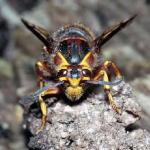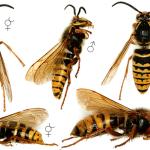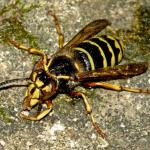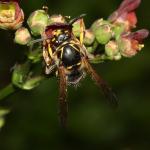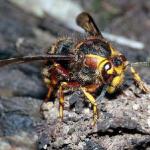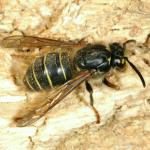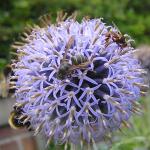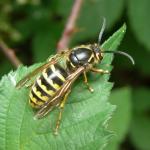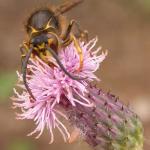Dolichovespula borealis LEE 1986, preocc.; Dolichovespula conjugens PAUL 1943; Vespa crassa HERRICH-SCHÄFFER 1841; Vespa flavicincta SCHENCK 1853; Vespa geerii LEPELETIER 1836; Vespa lineolata PÉREZ 1910; Vespa rufoscutellata SCHENCK 1853; Vespa similis SCHENCK 1853; Dolichovespula sugare ISHIKAWA 1969
The 'median wasp' is a very large social species, most individuals being second only to the hornet, Vespa crabro, in size. Queens of D. media also resemble V. crabro in their mainly yellowish-orange coloration. The gasters of many workers are very dark, with narrow yellow bands. Most colonies are rather docile; others seem to be very aggressive, attacking with little provocation (Welch & Irwin, 1995).
When recording began, Britain was host to seven species of social wasps. However, in the 1980s a further two species colonised the country: Dolichovespula media and D. saxonica. The first record of D. media in England was a male collected in Friston Forest, East Sussex, by S J Falk in August 1980 (Falk 1982). Five years later, an occupied nest was discovered near Robertsbridge, also in East Sussex. In 1987 a second nest was reported from near Canterbury, East Kent and, since then, the species' range has rapidly increased. By the end of the 1995 season the wasp had been reliably recorded from numerous sites from Kent to Cornwall, northwards to north Wales, Cumbria (Borrowdale in the Lake District) and Durham (Darlington) (Else, 1989, 1992a, 1993b, 1994a).
This species is now quite common and widely distributed so that the statuses allocated in Shirt (1987) - RDB3, and Falk (1991) - Na, no longer apply.
Virtually ubiquitous in lowland areas, though the majority of nest records are from private gardens, sometimes in large cities.
No published records in Britain, but probably April-September.
Nests of D. media are built in aerial sites, in nearly all cases suspended from the branches of trees and shrubs, from ground level to a height of several metres. The surrounding foliage usually hides a nest and protects it from rain and direct sunlight. A few nests have been found attached to the walls of houses; other nest sites include a lamp bracket and beneath the eaves of a caravan. Nests are constructed from wood fibres collected from both sound and apparently rotten timber (workers visit weathered fence posts for the purpose). In the spring and early summer, embryo (or queen) nests are unusual (for British wasps) in having a long, spout-like vestibule to the entrance at the bottom of the nest; this feature is lost later. Queens have been found hibernating in and under logs, perhaps indicating that this species prefers a humid site in which to spend the winter.
There is no evidence that this wasp is having an adverse effect on other British social wasps, but workers have decimated a honey bee hive (Whitehead, 1996).
In the spring, queens visit wall cotoneaster, black currant and rhododendron blossom. Later in the season, males and workers visit many other flowers. Workers also feed on honeydew on leaves, sap flows from oak trees ('oak flux'), and exudations from trees containing goat moth (Cossus cossus) caterpillars.
1997


